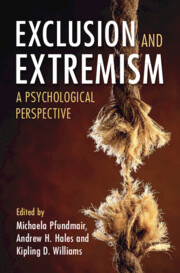Book contents
- Exclusion and Extremism
- Exclusion and Extremism
- Copyright page
- Dedication
- Contents
- Contributors
- Introduction
- Part I The Link between Exclusion and Extremism
- 1 Ostracism and Extremism
- 2 Exclusion and Radicalization
- 3 In the Realm of Action
- 4 Seeking the Self in the Extreme
- 5 Buying the Blackpill
- Part II Drivers of the Exclusion–Extremism Link
- Part III Topics Related to the Exclusion–Extremism Link
- Index
- References
5 - Buying the Blackpill
Perceived Exclusion and the Psychology of Incels
from Part I - The Link between Exclusion and Extremism
Published online by Cambridge University Press: 16 May 2024
- Exclusion and Extremism
- Exclusion and Extremism
- Copyright page
- Dedication
- Contents
- Contributors
- Introduction
- Part I The Link between Exclusion and Extremism
- 1 Ostracism and Extremism
- 2 Exclusion and Radicalization
- 3 In the Realm of Action
- 4 Seeking the Self in the Extreme
- 5 Buying the Blackpill
- Part II Drivers of the Exclusion–Extremism Link
- Part III Topics Related to the Exclusion–Extremism Link
- Index
- References
Summary
Involuntary celibates (“incels”) are men who desire romantic or sexual partners but purportedly cannot attain them. Their ideology – the Blackpill – holds that their exclusion from successful romantic and sexual relationships is due almost entirely to their relative unattractiveness. Furthermore, the consequences of being an unattractive man bleed over into other aspects of their lives, marring their interpersonal relationships, job prospects, and overall well-being. Blaming women as the chief architects of their unhappiness, incels sometimes commit mass acts of violent retribution. In this chapter, we explicate the incel ideology; explore the interrelated phenomena of social exclusion, self-verification, and identity fusion among incels; describe who incels are; and provide a framework for de-fusing incels from the group.
- Type
- Chapter
- Information
- Exclusion and ExtremismA Psychological Perspective, pp. 97 - 120Publisher: Cambridge University PressPrint publication year: 2024



